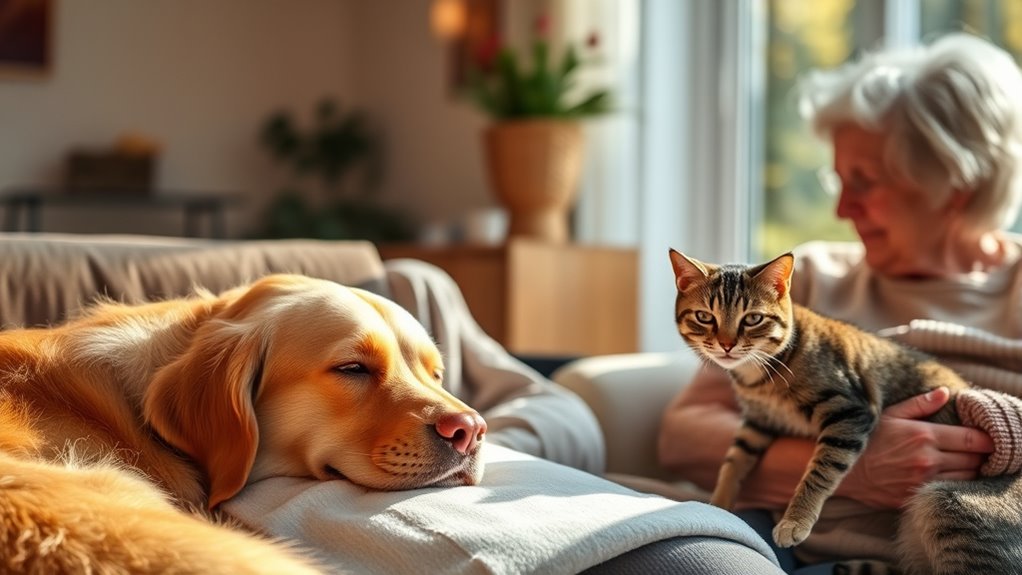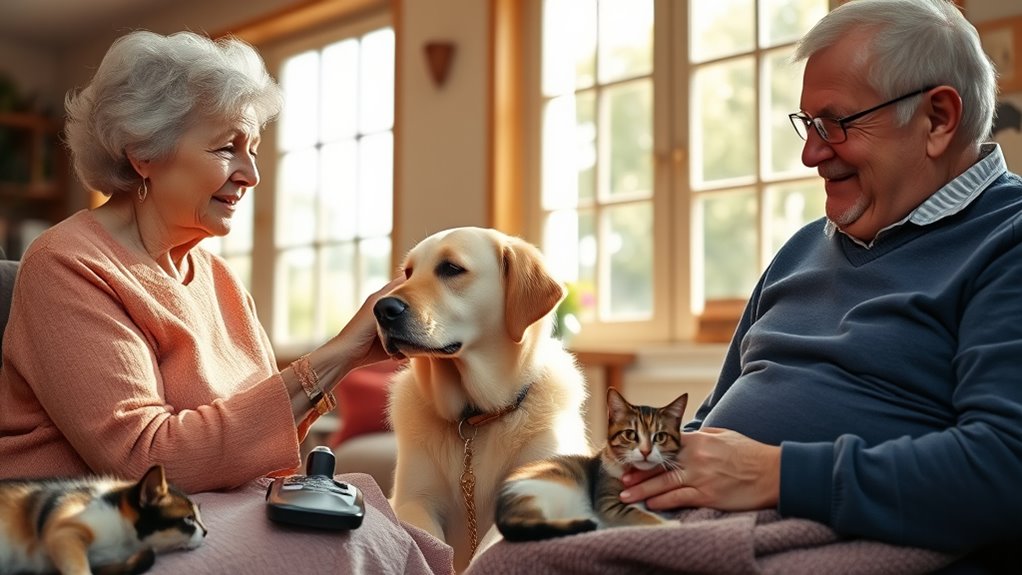Pet therapy offers numerous benefits for elderly care by enhancing emotional, physical, and social well-being. Interacting with therapy animals can reduce feelings of loneliness, boost mood, and create a calming environment that lowers stress. These animals encourage movement, social engagement, and foster a sense of purpose. Their gentle presence can evoke happy memories and provide comfort, helping seniors feel valued and connected. Stay with us to discover more about how animals transform elderly care experiences.
Key Takeaways
- Pet therapy reduces loneliness and promotes emotional well-being among elderly individuals.
- Interacting with therapy animals encourages physical activity and social engagement.
- Therapy animals provide comfort, safety, and evoke positive memories, enhancing emotional support.
- They serve as non-judgmental companions, fostering connections and reducing feelings of isolation.
- Incorporating animals into elderly care offers a natural, enjoyable way to improve overall quality of life.

Pet therapy offers a powerful way to improve your emotional and physical well-being. When you participate in animal-assisted therapy, you’re engaging in a form of treatment that harnesses the natural bond between humans and animals to promote healing and comfort. For elderly individuals, this connection can be especially meaningful, helping to alleviate feelings of loneliness and boost overall emotional well-being. As you interact with therapy animals—whether through gentle petting, playing, or simply being in their presence—you tap into a source of unconditional love and companionship that can markedly enhance your mental health.
Animal-assisted therapy provides more than just emotional support; it also encourages physical activity and social engagement. When an elderly person interacts with a therapy dog or cat, they often find themselves more motivated to move around, reach out, or participate in activities that they might otherwise avoid. This increased activity can improve mobility, reduce feelings of depression, and foster a sense of purpose. The presence of animals in care settings creates a calming environment that reduces stress and anxiety, further contributing to emotional well-being. It’s not just about petting the animals but about forming genuine connections that help you feel valued and understood.
You’ll notice that animals used in therapy are specially trained to respond to the needs of elderly individuals. They’re gentle, patient, and intuitive, helping you feel safe and comfortable. This non-judgmental companionship can considerably lessen feelings of isolation, which are common among seniors living alone or in care facilities. The simple act of sharing your space with an animal can evoke memories of past pets or childhood, reinforcing positive emotions and fostering a sense of familiarity. These interactions often lead to increased socialization, as you may feel more inclined to engage with caregivers, family members, or fellow residents when animals are present.
Trained therapy animals foster safety, comfort, and socialization, helping seniors feel connected and less isolated.
Incorporating animal-assisted therapy into elderly care settings is a practical way to enhance emotional well-being without relying solely on medication or traditional therapies. It’s a natural, enjoyable approach that taps into the inherent human-animal bond to promote healing. Whether you’re seeking comfort during difficult times or simply looking to add joy to your daily routine, the presence of therapy animals can transform your experience. The companionship, affection, and emotional support they provide serve as a reminder that you’re not alone, and that healing can be simple, gentle, and accessible through the power of animals.
Frequently Asked Questions
How Do Pets Improve Mental Health in Elderly Residents?
You might wonder how pets boost mental health in elderly residents. They foster emotional bonding, providing comfort and reducing loneliness. Pets also encourage cognitive stimulation by engaging residents in activities like pet care and play, which helps maintain mental sharpness. As you see these interactions, you’ll notice improvements in mood and overall well-being, making pets valuable companions that support mental health through connection and mental engagement.
Are There Specific Animals Best Suited for Elderly Care?
Imagine finding the perfect companion for your loved ones; certain species are better suited for elderly care. You should consider species compatibility and activity preferences, as these guarantee a comfortable and joyful bond. Gentle dogs, such as smaller breeds, often match well with seniors who appreciate gentle activity. Cats, with their calm presence, suit those seeking quiet companionship. Thoughtfully selecting animals based on individual needs can truly enhance well-being and happiness.
What Training Do Therapy Animals Undergo for Elderly Visits?
You ask about the training therapy animals undergo for elderly visits. They typically go through animal socialization to confirm they’re comfortable around people and new environments. Additionally, handlers often obtain certification to demonstrate they understand proper care and safety procedures. This training helps verify the animals are calm, friendly, and well-behaved, creating a positive, safe experience for seniors and fostering meaningful connections during visits.
How Do Pet Therapy Programs Measure Success?
Imagine a heartwarming smile—that’s how you know your efforts make a difference. You measure success by tracking behavioral improvements and measuring patient happiness, seeing tangible changes in mood and engagement. Surveys, observational notes, and feedback from staff and residents help gauge emotional well-being. These tools paint a clear picture of how pet therapy enriches lives, turning fleeting moments into lasting memories of comfort and joy.
What Precautions Are Taken to Ensure Elderly Safety During Sessions?
During pet therapy sessions, you prioritize elderly safety by following strict session safety protocols, including screening for pet allergy awareness. You make certain animals are well-trained and healthy, and you monitor interactions closely. You also educate staff and participants about allergy signs and proper handling. These measures help prevent allergic reactions and accidents, creating a safe, enjoyable environment for everyone involved.
Conclusion
Imagine the gentle purr of a cat or the wag of a dog’s tail easing loneliness in your golden years. As these animals bring comfort and joy, they stand as living reminders that companionship can be simple yet powerful. In a world often filled with silence and solitude, pet therapy offers a vibrant splash of life, turning quiet moments into lively memories. Embrace this bond, and let animals fill your days with warmth and purpose.









